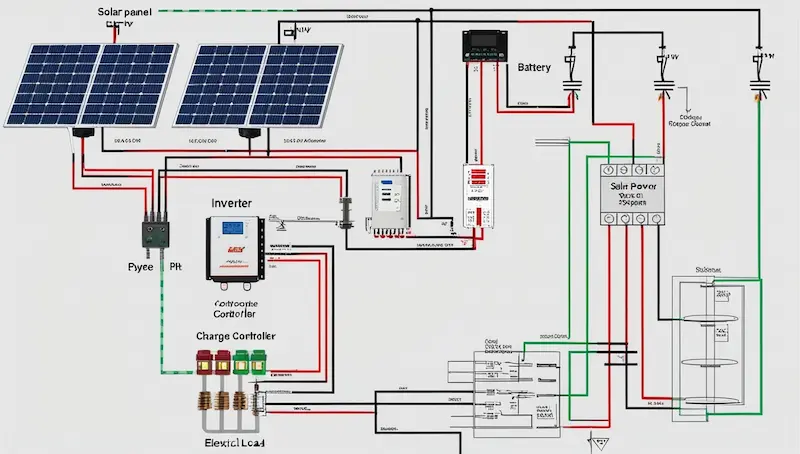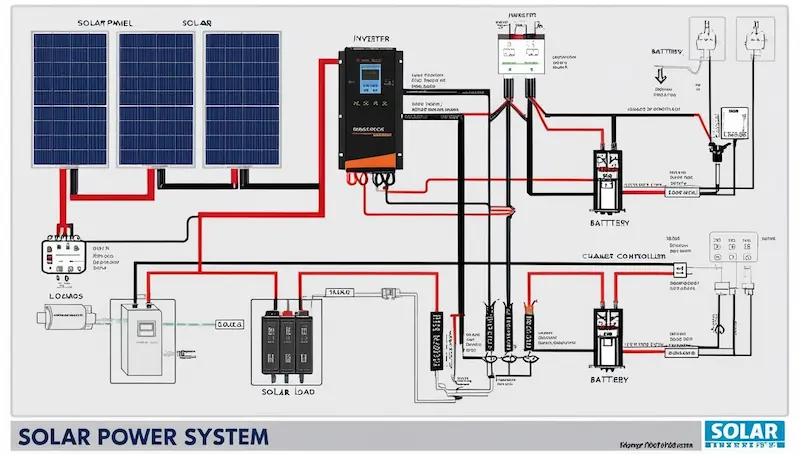Avoid Costly Errors: Essential Solar Wiring Diagram Tips
Updated: 13 Sep 2024
36
Do you plan on installing a solar setup and wish to ensure everything works out well? It is very important to learn what a solar panel wiring diagram looks like so that one does not waste a lot of money or end up with dangerous wiring. In this article, we will share some important tips and recommendations that you need to consider when drawing your perfect solar circuit diagram.

A typical solar system installation is complex, and many people end up making mistakes that result in poor efficiency or even the system’s destruction. Most of the time, there is a problem with the circuit diagram of the solar product in question, and this all boils down to the lack of a well-designed solar circuit system. Unlike some of the guides out there, this article focuses more on the how aspect when it comes to avoiding the above mistakes, offering clear, easy-to-follow tips that will enable you to create a good Solar Panel circuit diagram for a particular project.
Understanding Solar Panel Wiring Diagrams
Understanding solar panel circuit systems is crucial for solar panel installation. Wiring solar panels together in series helps maximize energy output by converting direct current to alternating current using string inverter systems. Whether configuring one or multiple solar panels, proper cable management and fuse placements ensure safety and efficiency.
Schematics: Wiring Solar Panels and Batteries in Series and Parallel

When it comes to connecting the solar panels and batteries in series or parallel, the technical drawing shown below for wiring is very important to consider. Batteries or solar panels are joined in a series means that the voltage raised combined with many applications is needed in high voltage. However, when wired in parallel, the current density rises to meet the conventional voltage desire, which is more suitable for high-cost power loads. These configurations can be combined to create a more flexible arrangement in response to particular energy requirements. These connections are better illustrated by clear technical drawings, which will enable easier assembly of the solar power system as well as ensure the safety of the system and, at the same time, enhance efficiency.
Schematic Solar Panel Wiring Diagram
A solar circuit diagram is recommended for any solar project because it may be done by a professional or an amateur. It operates as a comprehensive roadmap that systematically displays relations of the several substations of the solar panel, such as inverters, battery, and charge controller, among other electrical loads. This also makes it very easy to differentiate how the energy is distributed and can also make it possible to connect each one as they should, which, in the long run, would have taken a lot of money. The efficiency of the system has been enhanced. This is particularly essential to the first-time user and probably the most experienced engineer when it comes to diagnosing problems and modifying certain systems.
Technical drawing Diagram for Wiring Solar Cells in Series
Among the most common methods used in the wiring of solar cells is the wiring of the batteries in series to try to raise the voltage rating of the battery bank. However, this will not in any way change the capacity or the amp hours of a single Among the most common methods used in the wiring of solar cells is the wiring of the batteries in series to try to raise the voltage rating of the battery bank. However, this will not change a single cell’s capacity or amp hours. This configuration is especially advantageous in a situation where one would need a higher voltage system in his or her solar power system.
Schematic for Wiring Solar Panels in Parallel
A series connection of solar panel circuits enhances your solar assembly’s total current (amperage) capability, while the voltage will be the same with a single solar panel. This configuration is preferable to scenarios where a higher current is needed to power power-hungry peripherals or charge cells in a shorter time.
Key Points:
Current Addition:
In a parallel connection, the current from each of the panels is combined totally. For instance, two 12V and 5A can be wired in parallel, thus achieving an amperage of 10A while the voltage remains 12V.
Same Voltage:
The voltage stays constant and is equal to the voltage that is present in a single panel.
Steps for Wiring in Parallel:
Connect All Positive Terminals Together:
United the cathode of all the panels.
Connect All Negative Terminals:
Likewise, join all the negative terminals together in the same manner and then connect all the negative terminals of all the panels.
Output Leads:
The positive terminal is connected to the system’s positive input, while the negative terminal is connected to the system’s negative input.
Wiring Solar Batteries in Parallel
The synchronization of the solar cell can be done in parallel, which increases the general capacity of a solar energy system as the voltage remains constant. This process enables one to join many cells together so that all the cells contribute towards power storage while avoiding putting a lot of pressure on a given battery unit. In wiring batteries in parallel connections, it is advisable to use similar battery types and have the same rating to avoid situations that may arise and lead to many losses. Braided and connected positive terminals and negative terminals should be well connected to make your solar cells perform and last long.
How should solar panels be wired?
In powering the system, the solar panels can be wired in a series or parallel to suit the required voltage and current. In a series connection, the voltage ranges add, but the current remains constant, making it perfectly suitable in applications involving high voltage. On the other hand, parallel wiring maintains the voltage to a given level while increasing the current, ideal for use in low-voltage circuits. The decision regarding these configurations should be made concerning the voltage of the inverter and the overall power demand of the connected devices.
How can I tell which wire is positive and negative on solar panels?
Typically, solar panels come with labeled wires: It is generally associated with red insulation and may bear a “+” sign, whereas the second may bear symbols of black insulation and a “−” symbol. Moreover, it is possible to verify polarity by measuring voltage with the help of a multimeter, based on which the results will be positive if the probe that should be connected to the positive wire is attached to the corresponding wire.
How to wire a solar system to a house?
To wire a solar system to a house, the following steps should be followed; First, you fix the solar panels on the roof or any appropriate area available in the house and ensure they are well fixed and wired appropriately. Wire the panels either in series or in parallel, depending on the necessity of your system, then take the output to charge the controller to control voltage to batteries or directly to the inverter if it is grid-connected. Last but not least, you must connect your inverter to the electrical panel according to state regulations while practicing all the required precautionary measures.
Do you wire 12V solar panels in series or parallel?
The wiring of 12V solar panels is most beneficial when one wants to enhance the voltage of a solar system, thus reducing the current loss when traveling great distances. On the other hand, if your application demands a higher current at the same voltage, it is preferable to wire them in parallel. Last but not least, it should meet the requirements of a solar energy system in terms of compatibility with the inverter and load management.
Conclusion
This paper identifies the need to understand the wiring of a solar system to get the most out of the system and avoid mistakes. Adopting clear technical drawings for wiring the solar panels and cells, whether serial or parallel, makes it easier to satisfy a certain energy requirement. From this paper, it will be clear that best practices in solar power systems help determine installation safety, effectiveness, and durability, which in turn assist beginners and experts in the sector in successful implementations.
Please Write Your Comments